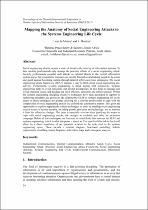JavaScript is disabled for your browser. Some features of this site may not work without it.
- ResearchSpace
- →
- Research Publications/Outputs
- →
- Conference Publications
- →
- View Item
| dc.contributor.author |
Mouton, F

|
|
| dc.contributor.author |
Leenen, L

|
|
| dc.contributor.author |
Malan, MM

|
|
| dc.contributor.author |
Venter, HS

|
|
| dc.date.accessioned | 2015-03-12T10:24:15Z | |
| dc.date.available | 2015-03-12T10:24:15Z | |
| dc.date.issued | 2014-08 | |
| dc.identifier.citation | Leenen, L and Mouton F. Towards an ontological model defining the social engineering domain. Springer Berlin Heidelberg 2014, Turku, Finland, 30 July - 1 August 2014 | en_US |
| dc.identifier.isbn | 978-3-662-44207-4 | |
| dc.identifier.issn | 1868-4238 | |
| dc.identifier.uri | http://hdl.handle.net/10204/7953 | |
| dc.description | 11th IFIP TC9 Human Choice and Computers Conference, Turku, Finland, 30 July - 1 August 2014. Due to copyright restrictions, the attached PDF file only contains the abstract of the full text item. For access to the full text item, please consult the publisher's website | en_US |
| dc.description.abstract | The human is often the weak link in the attainment of Information Security due to their susceptibility to deception and manipulation. Social Engineering refers to the exploitation of humans in order to gain unauthorised access to sensitive information. Although Social Engineering is an important branch of Information Security, the discipline is not well defined; a number of different definitions appear in the literature. Several concepts in the domain of Social Engineering are defined in this paper. This paper also presents an ontological model for Social Engineering attack based on the analysis of existing definitions and taxonomies. An ontology enables the explicit, formal representation of the entities and their inter-relationships within a domain. The aim is both to contribute towards commonly accepted domain definitions, and to develop a representative model for a Social Engineering attack. In summary, this paper provides concrete definitions for Social Engineering, Social Engineering attack and social engineer. | en_US |
| dc.language.iso | en | en_US |
| dc.publisher | Springer Berlin Heidelberg | en_US |
| dc.relation.ispartofseries | Workflow;14014 | |
| dc.subject | Bidirectional Communication | en_US |
| dc.subject | Compliance Principles | en_US |
| dc.subject | Indirect Communication | en_US |
| dc.subject | Ontology | en_US |
| dc.subject | Social Engineering Attack | en_US |
| dc.subject | Social Engineering Attack Ontology | en_US |
| dc.subject | Social Engineering Definitions | en_US |
| dc.subject | Social Engineering History | en_US |
| dc.subject | Taxonomy | en_US |
| dc.subject | Unidirectional Communication | en_US |
| dc.title | Towards an ontological model defining the social engineering domain | en_US |
| dc.type | Conference Presentation | en_US |
| dc.identifier.apacitation | Mouton, F., Leenen, L., Malan, M., & Venter, H. (2014). Towards an ontological model defining the social engineering domain. Springer Berlin Heidelberg. http://hdl.handle.net/10204/7953 | en_ZA |
| dc.identifier.chicagocitation | Mouton, F, L Leenen, MM Malan, and HS Venter. "Towards an ontological model defining the social engineering domain." (2014): http://hdl.handle.net/10204/7953 | en_ZA |
| dc.identifier.vancouvercitation | Mouton F, Leenen L, Malan M, Venter H, Towards an ontological model defining the social engineering domain; Springer Berlin Heidelberg; 2014. http://hdl.handle.net/10204/7953 . | en_ZA |
| dc.identifier.ris | TY - Conference Presentation AU - Mouton, F AU - Leenen, L AU - Malan, MM AU - Venter, HS AB - The human is often the weak link in the attainment of Information Security due to their susceptibility to deception and manipulation. Social Engineering refers to the exploitation of humans in order to gain unauthorised access to sensitive information. Although Social Engineering is an important branch of Information Security, the discipline is not well defined; a number of different definitions appear in the literature. Several concepts in the domain of Social Engineering are defined in this paper. This paper also presents an ontological model for Social Engineering attack based on the analysis of existing definitions and taxonomies. An ontology enables the explicit, formal representation of the entities and their inter-relationships within a domain. The aim is both to contribute towards commonly accepted domain definitions, and to develop a representative model for a Social Engineering attack. In summary, this paper provides concrete definitions for Social Engineering, Social Engineering attack and social engineer. DA - 2014-08 DB - ResearchSpace DP - CSIR KW - Bidirectional Communication KW - Compliance Principles KW - Indirect Communication KW - Ontology KW - Social Engineering Attack KW - Social Engineering Attack Ontology KW - Social Engineering Definitions KW - Social Engineering History KW - Taxonomy KW - Unidirectional Communication LK - https://researchspace.csir.co.za PY - 2014 SM - 978-3-662-44207-4 SM - 1868-4238 T1 - Towards an ontological model defining the social engineering domain TI - Towards an ontological model defining the social engineering domain UR - http://hdl.handle.net/10204/7953 ER - | en_ZA |









